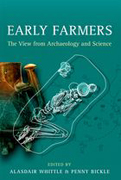
Early Farmers: The View from Archaeology and Science
Whittle, Alasdair
Bickle, Penny
Covers many features of the Neolithic way of life - a much debated period of history Introduces varied scientific analyses used by archaeologists - helpful for non-specialists Up-to-date debate about how best to interpret archaeological evidence - broad application to archaeology as a whole The Neolithic period was one of the great transformations in human history with profound, long-term consequences. In Europe, there were no farmers at 7000 cal BC, but very few hunter-gatherers after about 4000 cal BC. Although we understand the broad chronological structure of this shift, many pressing research questions remain. Archaeologists are still vigorously debating the identity of those principally involved in initiating change, the detail of everyday lives during the Neolithic, including basic questions about settlement, the operation of the farming economy and the varied roles of material culture, and the character of large-scale and long-term transformations. They face the task not only of working at different scales, but of integrating ever-expanding amounts of evidence. As well as the data coming from larger and more intensive excavations, there has been a radical increase in the information released by many kinds of scientific analysis of archaeological remains. These now include, alongside longer established methods of looking at food remains and material, the isotopic analysis of the diet and lifetime movement of people, isotopic analysis of cereal remains for indications of manuring, a DNA analysis of genetic signatures, detailed micromorphological analysis of deposits where people lived, and the close examination of the origin and production of varying materials and artefacts. The 21 chapters by leading experts in the field demonstrate how the combination of archaeological and scientific evidence now provides opportunities for new and creative understandings of Europe's early farmers. They make an important contribution to the debate over how best to integrate these multiple lines of evidence, scientific and more traditionally archaeological, while keeping in central focus the principal questions that we want to ask of our data.
- ISBN: 978-0-19-726575-8
- Editorial: OXFORD UNIVERSITY PRESS.
- Encuadernacion: Tela
- Páginas: 400
- Fecha Publicación: 13/11/2014
- Nº Volúmenes: 1
- Idioma:
